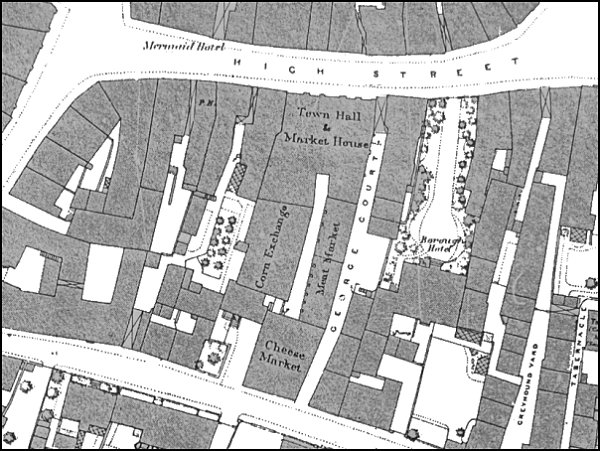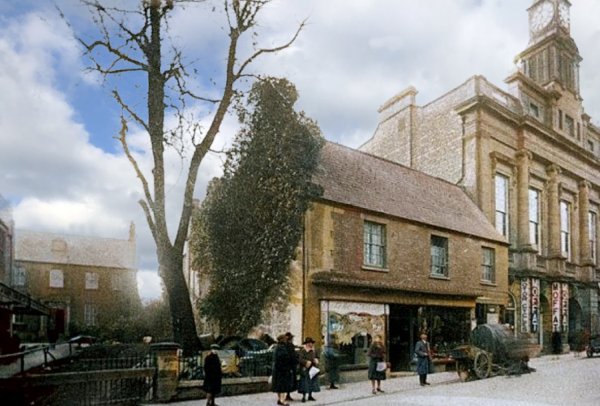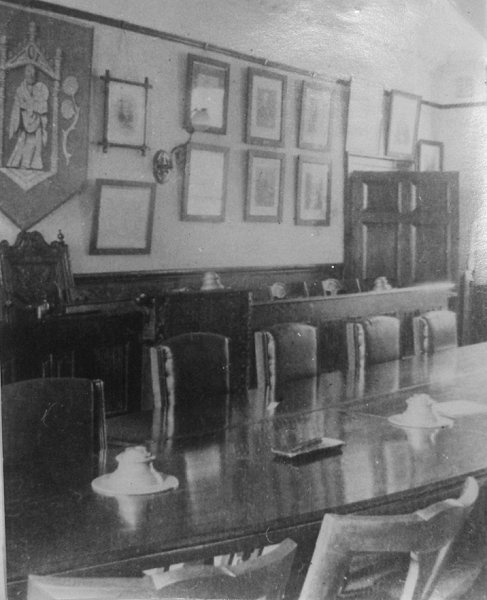Borough House
Borough House
High Street / The Borough
Borough House was originally an 18th century house in High Street, but there are records predating the building of the house. In 1615 the Portreeve's Accounts in its 'Rent of Assize in High Streete' records "Imprimis Received of Matthew Hacker for the Rent of a Tenemente this year - 16s 0d". The tenement became known as Hacker's Plot and in 1669 the Portreeve's Accounts show "Rec. of Frauncis Keymer for his Fyne upon an Estate in a plott of ground lyinge next the George Inn called Hacker's plott.... £5 0s 0d." and later in the same accounts "Item Rec'd of Frauncis Keymer for the rent of his tenement there.... 16s 0d."
An advertisement in the Western Flying Post of 1753 shows that an inn called the Bell Inn was on the site at this date - "Whitmarsh's stagecoach left from the Bell Inn every Tuesday and reached London by Saturday, returning the following week". The Bell is known to have been in existence by 1736 when it was run by Widow (Annabella) Rooks, late Ann Bowditch (Portreeve's Account Book) until 1764 when a conveyance in the Donn Papers recorded "Benjamin Dymond, innholder of Weymouth, to Edward Boucher the younger, gent of Yeovil - Dwellinghouse, etc., in High Street between tenement lately of Annabella Reeks, and now of John Lock called the Bell Inn, on west and tenement in possession of Ann Penny, widow, on east, lately in possession of Robert Helliar, then of Theodosia Helliar, widow, who intermarried with Benjamin Dymond and is since dead, and now in possession of Thomas Slade, apothecary."
As stated above the building known as Borough House was originally an 18th century house and so was, perhaps, built on the site of the Bell Inn rather than being the Bell Inn itself. In any event Borough House was a five-bay, two-storey with attic stone-built house with a porch supported by Corinthian columns. On the south side of the Borough, it was set back somewhat from the road. In fact it was located nearly halfway between High Street and South Street.
The house is known to have been the residence of surgeon William Fancourt Tomkins in the early 1840s and then Thomas Binford, who was Portreeve in 1853, from at least 1846. The 1886 Ordnance Survey map shows the building listed as the Borough Hotel although trade directories of the 1840's and 1850's, as well as the 1891 census, list it as the Bell Inn. Having said that, the 1881 census shows it to have been the residence, and probably the medical practice, of Dr George Flower, later of Flower's House in Hendford.
Early in 1889 notice was served on the occupants of Borough House for a new Town Hall project. Borough House was purchased by Yeovil Corporation in 1898 to be used as the town’s first municipal offices, and was adapted for the Corporation's use at the cost of £100. In July 1889 the Council met here for the first time, although the premises were not formally opened until October. "The room, though not spacious, was sufficient and the Aldermanic bench was enriched with 15th century linenfold panelling now preserved in the Museum." (Goodchild, 1954).
The building served as a council chamber and offices until it was demolished in 1924 for the new development of King George Street.
map

The 1886 Ordnance Survey showing the Town Hall & Market House, the Corn Exchange, Meat Market and the Cheese Market facing South Street. To the right, next to George Court, is shown Borough House labelled as the 'Borough Hotel' to the east of George Court.
gallery

This colourised photograph of about 1915 shows the former Bell Inn, at left, set well back from High Street. By the time of this photograph the building was called Borough House and was used as municipal offices. The tree and shop at centre are in the position of where King George Street now joins High Street and the tall building at right is the old Town Hall (built in 1849) with its tower and gas-illuminated clock, installed in 1912. The Town Hall was destroyed in 1935 by a fire believed to have been caused by paper rubbish blowing into the tower and ignited by the gas jets illuminating the clock.

This
colourised photograph
features in my
book 'Yeovil From Old Photographs'.
A photograph of the Bell Inn taken about 1880 showing the fine Corinthian columns supporting the porch and the bow-headed window above - a nice architectural touch.

This
photograph
features in my
book "Lost Yeovil"
The Council Chamber, Borough House, photographed around 1915. At left is glimpsed the 15th century linenfold panelling enriching the "Aldermanic bench". The photographs of members of the Corporation on the wall were taken and presented by Jarratt Beckett, photographer of Hendford.